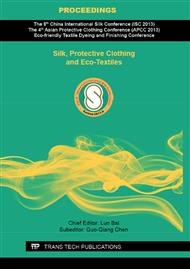p.593
p.601
p.607
p.613
p.617
p.623
p.630
p.634
p.639
Evaluation of Functional Underwear for Firefighter Clothing by Total Heat Loss
Abstract:
Synthetic textile such as polyester and poly-urethane has been used for underwear in terms of moisture release and function in underwear. However, the synthetic underwear has high risk for skin burns due to melting and shrinking by heat. Thermal protection and comfort in fire fighter protective clothing is always trading off, but fire fighters tend to use the synthetic underwear to feel comfort and function during firefighting operation without understanding of the risk for skin burns by the textile. Objective of this study is to investigate if the synthetic underwear plays a significant role in moisture and metabolic heat transfer within the fire fighter clothing by total heat loss measurement. Measurement of the total heat loss has been conducted by the ASTM F-1868 instrument (Kato-Tech, Co. Ltd., Japan). Three type of fire fighter clothing, one station wear, and five types of underwear have been used for the test. Test has been conducted for each clothing and combination of clothing. The results shows that range of total heat loss is 322.3 W/m2 to 385.3 W/m2, 857.9 W/m2, 782.3 W/m2 to 897.3 W/m2 for three fire fighter clothing, one station wear and five underwear, respectively. However, when the fabrics of fire fighter clothing, station wear and underwear were piled up, the range of total heat loss decreased to 242.1 W/m2 to 304.4 W/m2. The data indicates that the fire fighter's multi-layer fabric controls the heat and moisture transfer within fire fighter clothing and no positive contribution by any types of underwear.
Info:
Periodical:
Pages:
617-622
Citation:
Online since:
September 2013
Authors:
Keywords:
Price:
Сopyright:
© 2013 Trans Tech Publications Ltd. All Rights Reserved
Share:
Citation:


